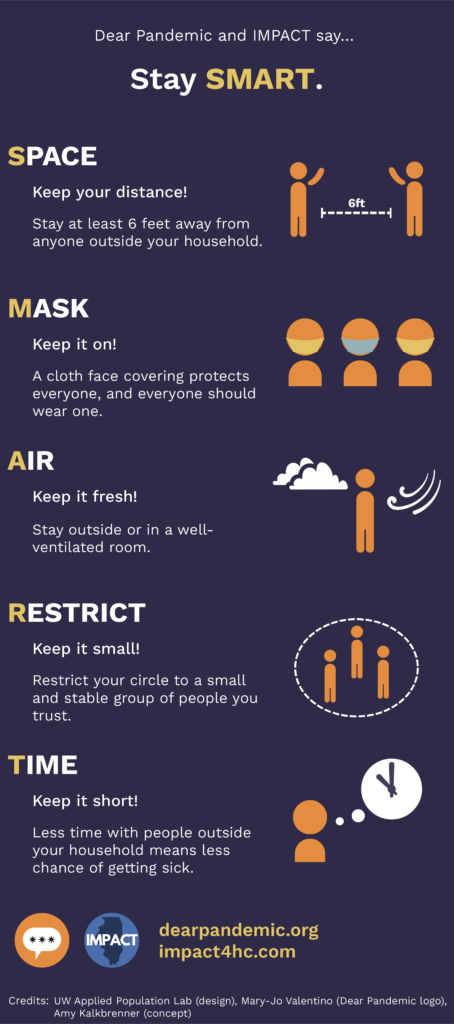Q: The new coronavirus strain is more transmissible than the older strain. Does this mean our usual precautions (masks, 6 foot distance, being outside) are less effective?
A: Luckily, no. Virus mutations still don’t defy the laws of physics. But we need to be more vigilant about existing precautions.
The new variant is transmitted the same way as all the other variants of SARS-CoV-2, so you can reduce risk with the same #StaySMART additive precautions:
↔️ Space: Keep your distance from other people.
😷 Masks: Keep your nose + mouth covered.
💨 Air: Keep it fresh.
🔄 Restrict: Keep your circle small.
⏲️ Time: Keep your interactions brief.
We recently covered what increased transmissibility of this new variant means.
But HOW exactly do scientists think the virus is transmitted more easily? Scientists are still investigating, but there is some recent evidence that patients with the variant have higher viral loads in their respiratory tracts, which means infectious individuals could pass on more virus per breath or cough (see link below). Other possibilities are that the mutations allow the virus to enter cells more easily, thus requiring fewer virus particles to take hold as an infection. The variant could make people infectious for longer, increasing their opportunities to spread.
As you can see, none of these mechanisms include viruses evolving to get around masks, distancing, or good old soap and water.
🔐 But it does mean we should tighten up our existing virus security.
Recall, the biggest risk is SHARING AIR with someone, breathing the air that they exhale.
The exhaled breath contains particles most concentrated close to the person breathing or speaking (picture your breath outside on a cold day). 😮💨
SPACE & MASKS can minimize your breathing in the exhaled breath of others. The virus is carried by particles of mucus and saliva, so the distance these can travel is not changed by the new variant, nor is their ability to physically penetrate a mask.
AIR: While outside is best, remember that OUTSIDE IS NOT MAGIC if you are in close contact, especially without a mask. You can still breathe in that person’s breath. Indoors, ventilation (meaning introducing outside air) is key. This outside air dilutes any virus in the air, pushes it outdoors, and stops it from accumulating indoors. HVAC systems can be set to bring in maximal outside air, but it’s also as easy as OPENING DOORS & WINDOWS (see more specific tips in FAQ and Slide links below).
RESTRICT: Fewer people in a room also limits the concentration of exhaled breath in the room.
TIME: If you are indoors with an infectious person emitting more virus particles from their breath, a 10-minute interaction may be as risky as a 20-minute interaction was before. Keep duration as short as possible.
Finally, the most effective prevention of all is to minimize physical contact outside of your family bubble. The virus, no matter the variant, needs hosts to reproduce and survive, simple as that.
When that is not possible, use the strategies above to minimize your risk of transmission.
🧀 Remember the Swiss Cheese model—even lots of small measures with holes stacked together can add up to big protection.
#StaySMART #StopSwappingAir
Love,
Those Nerdy Girls
Further Reading:
“New Covid variant linked to higher viral load in respiratory samples”
“More infectious Covid variant forces review of UK workplace guidance”
FAQs on Protecting Yourself from COVID-19 Aerosol Transmission
Slide Presentation on Aerosol Transmission with suggestions on Filtration/Ventilation
CIDRAP “Stop Swapping Air” Campaign



